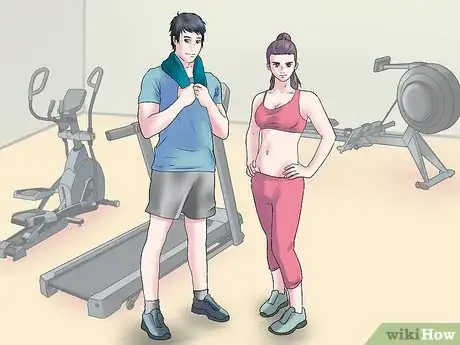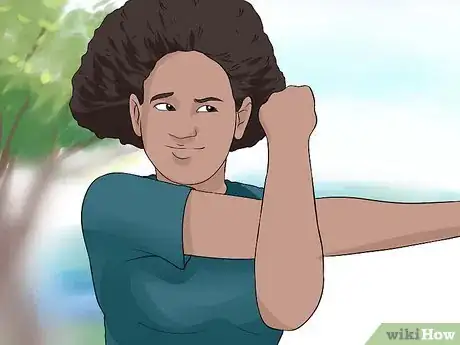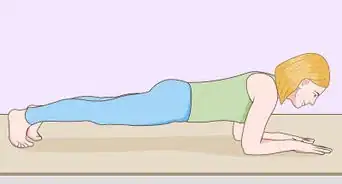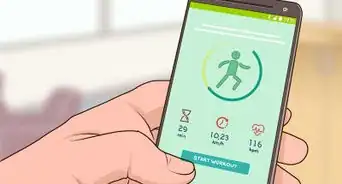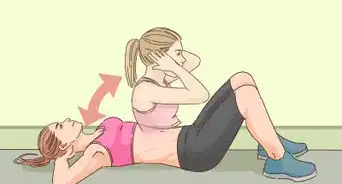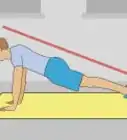This article was co-authored by Kevin Richardson. Kevin Richardson is a Celebrity Personal Trainer and the Founder of Naturally Intense Personal Training based in New York, New York. With over 30 years of experience, Kevin specializes in helping busy people achieve their fitness goals with his time-saving Naturally Intense High Intensity 10 Minute Workouts. Kevin is an International Fitness Consultant for UNICEF and one of the top lifetime natural bodybuilding champions. He is also a five-time winner of the Best of Manhattan Awards for Personal Training (2017, 2016, 2014, 2013, 2012). Kevin has been featured on CBS News and in the Wall Street Journal.
There are 11 references cited in this article, which can be found at the bottom of the page.
This article has been viewed 47,083 times.
Exercise can be a tremendously enjoyable and satisfying part of your daily routine. It can also feel like a grueling, pointless punishment depending on what exercises you’re actually doing. Based on a 2009 study published in the Scandinavian Journal of Medicine & Science in Sports, you are much more likely to stay physically active if you actually enjoy whatever you’re doing to stay fit.[1] This is why it’s so important to either choose activities that you enjoy, or modify your less-interesting exercises to make them more exciting!
Steps
Establishing a Fun Exercise Routine
-
1Identify and choose exercises you'll enjoy. Some people imagine a gym when they think of exercise, or perhaps jogging around the park. If you enjoy those things, then go for it. If not, then find something that you will enjoy. The easiest way to make exercise fun is by sticking with workout routines that you know you'll enjoy.[2]
- If you don't like certain exercises, like lifting weights, you don't have to do them.
- Some people find exercising outdoors (especially in nature) to be particularly satisfying.
- Try getting outside and going for a long walk, trail run, or hike at your local park.
- Many people enjoy revisiting activities they did as children. If you were a very active child (perhaps you biked everywhere or ran around the block to unwind), think about ways to revisit your childhood and incorporate that into your workout.
- If you like exploring your city or town, go for long bike rides. It's a great way to get exercise while seeing the sights or running errands.
-
2Download a fun fitness app. There are many fitness apps on the market today. Fitness apps can be downloaded to your smartphone or digital mp3 player, and they can be used to help you stay motivated during a workout, track your progress, and compare your workouts over time. [3]
- There's a good chance your smartphone might have come with a fitness app already on it. If not, you can download one for free or for a low cost.
- Look for apps like MyFitnessPal, MapMyFitness, Moves, Fitness Buddy, and Tabata.
- Most fitness apps have spoken instructions that can let you know your progress, tell you when to start/stop running, and keep track of time during your workout.
- You can listen to music through some workout apps if you have mp3s saved on your phone.
- Workout apps typically tell you how many miles/kilometers you've traveled, how long it took you to travel that distance, and how many calories you've burned. Many apps will also chart your route on a map (using your device's GPS) so you can see your route and follow it again in the future.
- There are many workout apps on the market today. Read other users' reviews online to find one that works best for you.
Advertisement -
3Put together a workout playlist to keep you pumped. Music can help motivate you during a workout. It can also help take your mind off of soreness and fatigue by keeping you grounded in your workout.[4] Put together a playlist of songs you love that will keep you moving and motivate you through your daily workout.
- The best songs to exercise to tend to have at least 120 beats per minute (BPM). You can find out a song's BPM by searching online.
- Stick with songs that have a positive message that will help you stay motivated.
- Choose songs that make you tap your fingers or feet. Anything that makes you want to move will probably help you work out.
- Choose something fun and exciting for your first track to help you get going, then choose fast-tempo music for the mid section of your workout. That's when you'll need motivation the most.
- Something with a catchy, steady rhythm is a good choice, as it will likely help you keep moving once fatigue sets in.
- Add motivational and/or catchy songs for the tail end of your workout, as your endurance will really be lagging by that point.
- Throw in one or two slower songs (like ballads) for the cool down part of your workout. You'll want to slow your breathing and heartbeat as you slowly walk off the workout, so something slower and more relaxing would be ideal.
-
4Join a supportive workout/weight loss group. Some people want to join a gym but worry about being around hyper-fit, athletic individuals. While some gyms may cater to that crowd, there are also many gyms and workout groups that focus on being supportive of everyone.[5]
- Look for gyms that specify they are supportive and inclusive of all body types.
- If you can't find a whole gym that's supportive, look for specific workout groups. You can find these at your local gym, or through online meet up groups.
- Search online for supportive or body-positive workout groups in your area.
-
5Reward yourself for your achievements. A good way to stay motivated is by rewarding yourself. It can be a good "carrot on a stick" to remind you through the exhausting daily workouts that you'll get some type of tangible reward for your efforts.
- Whether your aim was to lose weight, run a set distance without stopping, or exercise on consecutive days for a week in a row, it's important to celebrate those victories.
- Make sure you reward yourself in ways that won't compromise your newfound healthy lifestyle.
- Instead of going out for ice cream or alcoholic beverages, try treating yourself to a healthy homemade dinner, a hot bath, or some time watching your favorite show.
- Increase your reward as you prolong your workout regimen. For example, after a month you might treat yourself to something more expensive, like a movie or album you've been wanting.
- A reward that might keep you motivated is a new pair of running shoes (if you run), or some other type of workout gear. Investing money in something to help you work out might help you commit to your healthier lifestyle.
Changing Up Your Workout Routine
-
1Change your routine every few weeks.[6] If you've been working out with the same routine for a few weeks in a row, you might begin to feel bored. Your progress might also plateau, without any continued weight loss or muscle gain. Changing up your exercise routine can help avoid these workout pitfalls and keep your workout fresh and productive.[7]
- Your body's muscles adjust and adapt to a workout routine in about six to eight weeks. If you don't change up your routine, you may find that your progress stalls after this period.[8]
- One easy way to alter your routine is by increasing the intensity of your workouts. You can do this by adding more weights (if you lift weights) or by walking/running/biking faster and/or farther in short bursts (sometimes called interval training).[9]
- If you walk, add some light jogging. If you jog or run, add some sprinting intervals by setting your sights on a target ahead of you and sprinting as fast as you can. Then resume your normal jogging/running/walking speed.
- Sometimes just changing up the sequence of your workout can help make a difference. You'll essentially be retraining your muscles in a new pattern, which can help break out of your old, repetitive routine.
- If changing the sequence doesn't do much, you can try switching out different exercises into your regimen. For example, switch to bench presses instead of squats, or cut your run five minutes short and go for a quick bike ride around the block.
-
2Try out different types of exercise. Exercise should never feel boring or chore-like. If your workout routine starts to feel dull or if you've hit a plateau in your workout plans, try a new form of exercise that you may not have previously considered.[10] You may end up enjoying it, and it could be just the thing you need to break out of your slump.[11]
- Try some new and emerging fitness trend. This can help you explore your workout options while feeling like you're on the cutting edge of a new trend.
- You can find new classes at your local gym, community center, or local college/university. Search around online to find out about new classes being offered in your area.
-
3Take an exercise class. Whether you've been working out alone for a while, want to take the predictability out of your workout, or simply need help getting started, a group exercise class could be just the thing you need. Most gyms and exercise facilities offer group classes in yoga, Pilates, kickboxing, core conditioning, and various styles of aerobic dance.[12]
- Group workout classes allow you to exercise in a safe, fun, and social environment.
- The workout you get in a group exercise class is designed for maximum efficiency and safety, plus it offers a consistent schedule for your exercise regimen.
- You can find group exercise classes at your local gym, community center, and many colleges/universities. Some are open to the public, while others may require a membership fee.
- Try out a few different classes, and don't get discouraged if things don't click right away. Sometimes it takes a while to find an instructor, music style, or setting that works best for you.
-
4Get a workout buddy and motivate one another. If you have a hard time getting excited about exercise, or if you find that working out alone has gotten dull and repetitive, having a workout buddy could make a big difference. You can help each other - just make sure you choose the right friend to work out with.[13]
- Try to choose a friend who can stay motivated. Otherwise you might be working double duty, keeping both you and your friend on your workout routine.[14]
- Let your friend know that you're looking to commit to a serious workout routine, and that this isn't just a short-term, passing interest. Make sure your friend is also willing to commit for the long haul.
- Don't rely solely on your workout buddy. There will be days where your friend can't make it, and you'll need to commit to going out and exercising alone if you need to.
Reframing Your Perspective
-
1Exercise to feel good, not just for weight loss. If you're having trouble sticking with exercise, it may be because you've tried to lose weight in the past and couldn't succeed. One way to enjoy exercise in spite of this is to keep working out because it feels good and is enjoyable, not just to lose 10 pounds.[15]
- Some studies have shown that working out because it feels good and manages stress is a better motivator than working out just to lose weight.
- You can still make exercise part of your weight loss plan, but don't stop working out if exercise alone isn't dropping the pounds.
- Remind yourself that you'll feel happier and less stressed with exercise, and you'll sleep better at night. Those factors can help you stick with it if your scale starts to frustrate you.
"I didn't find exercise enjoyable until I realized that any movement is good movement. Rather than trying to push myself to perform at a specific intensity, I just try to find 30 minutes of movement in the day. I think of each little movement I do, like taking out that trash, as a tiny victory and additive to that 30-minute goal. This mindset shift — of thinking about my daily activities as exercise — helps me ease into exercise. It doesn't matter how long I do it. It just matters that I do it at all, and that's what feels good." -Thomas C, 28 year-old
-
2Identify your obstacles before they come up. Everyone makes excuses from time to time. Letting yourself keep making excuses can ruin your chances of ever getting started, though. If you're prone to making excuses or finding reasons why you shouldn't work out, make a list of your anticipated obstacles and find ways to preemptively avoid those pitfalls.[16]
- By anticipating your excuses before they arise, you'll be able to recognize them as they arise and work around them.
- If money is an issue, for example, you can exercise outdoors instead of joining a gym.
- If you can't find time to exercise, try getting up an hour earlier or staying up an hour later. You can also try making exercise part of your daily commute by riding your bike to work instead of driving.
- If you're really short on time, you can break your workout up into smaller sessions. Even working out 15 to 20 minutes at a time is an option, especially if you can do multiple short sessions throughout the day.
- Remember that any exercise is better than no exercise. Even short sessions will bring tremendous health benefits compared to doing nothing at all.
-
3Try to achieve flow. Flow is a popular term that gets brought up in studies about human happiness. It can apply to any activity you engage in, including exercise. If you're having a hard time getting into your exercise routine, try to keep going until you achieve some experience of flow in your workout.[17]
- Flow involves total immersion in the moment.
- People who achieve flow tend to feel happier and more fulfilled with their activities.
- Flow focuses on the process of working towards a goal rather than just centering on achievement.
- To achieve flow when you exercise, set clear and specific goals for every workout session.
- Listen to your body and mind for feedback during your workout.
- If you're pushing yourself too hard, or not hard enough, your body and mind should register the situation through soreness or a sense of not doing enough.
-
4Avoid pushing yourself too hard or too fast. Trying to do too much or progress too quickly can make an otherwise fun workout feel awful. It can also discourage you by making you feel like you can't keep up with your expectations. Instead of trying to become a world-class athlete overnight, aim to amp up your workout routine gradually and over a period of several weeks and months.[18]
- Starting out slowly will make the transition to exercising easier on your body. It can also help your brain develop stronger associations between exercise and pleasure.
- Start out with sessions that last around 5 to 10 minutes, especially if you're new to exercise or haven't done it in a while.
- Gradually add 5 to 10 minutes to your workout every week or two, but don't rush too fast. Doubling your workout time in a week could potentially cause injuries and may make exercise less fun.
- Aim to eventually (after a few months) reach 30 to 60 minutes of exercise each day, and try to work out around five days a week (or more if you feel capable).
Is It Better To Work Out In The Morning Or The Evening?
Expert Q&A
-
QuestionHow do I stop getting bored when exercising?
 Kevin RichardsonKevin Richardson is a Celebrity Personal Trainer and the Founder of Naturally Intense Personal Training based in New York, New York. With over 30 years of experience, Kevin specializes in helping busy people achieve their fitness goals with his time-saving Naturally Intense High Intensity 10 Minute Workouts. Kevin is an International Fitness Consultant for UNICEF and one of the top lifetime natural bodybuilding champions. He is also a five-time winner of the Best of Manhattan Awards for Personal Training (2017, 2016, 2014, 2013, 2012). Kevin has been featured on CBS News and in the Wall Street Journal.
Kevin RichardsonKevin Richardson is a Celebrity Personal Trainer and the Founder of Naturally Intense Personal Training based in New York, New York. With over 30 years of experience, Kevin specializes in helping busy people achieve their fitness goals with his time-saving Naturally Intense High Intensity 10 Minute Workouts. Kevin is an International Fitness Consultant for UNICEF and one of the top lifetime natural bodybuilding champions. He is also a five-time winner of the Best of Manhattan Awards for Personal Training (2017, 2016, 2014, 2013, 2012). Kevin has been featured on CBS News and in the Wall Street Journal.
Celebrity Personal Trainer I think that what we experience as boredom is actually a very natural reaction to doing the same thing over and over. Boredom is usually a symptom of two things. Number one, it's a mental perspective of you doing the same thing over and over and kind of getting tired after a while. And then number two, the fact that you're not only seeing the results. People who see great results all the time seldom get bored. They're really, really happy with what they're doing. And it's really important with all of our clients, as many people as we train, as many sessions that we do, every single routine is different. And I can't stress how important it is that every single time you train, you need to not just do the same old exercises the same old ways. You need to change the number of repetitions you do. You need to change the weights you do.
I think that what we experience as boredom is actually a very natural reaction to doing the same thing over and over. Boredom is usually a symptom of two things. Number one, it's a mental perspective of you doing the same thing over and over and kind of getting tired after a while. And then number two, the fact that you're not only seeing the results. People who see great results all the time seldom get bored. They're really, really happy with what they're doing. And it's really important with all of our clients, as many people as we train, as many sessions that we do, every single routine is different. And I can't stress how important it is that every single time you train, you need to not just do the same old exercises the same old ways. You need to change the number of repetitions you do. You need to change the weights you do.
Warnings
- Be careful and examine your surroundings, especially if you exercise outdoors. Watch out for cracks in the sidewalk and uneven surfaces. Be aware that there can be additional dangers in nature, like wild animals, biting/stinging insects, and a risk of getting lost.⧼thumbs_response⧽
- Don't over exercise. Try to do a lighter exercise or work a different part of your body sometime in the week if you wish to work out everyday.⧼thumbs_response⧽
- Make sure you are drinking enough water. You will sweat a lot while you exercise, so it's important to replenish that lost water by keeping a full bottle of cold water on hand.⧼thumbs_response⧽
- Talk to your doctor before beginning any exercise regimen. Exceeding your physical capabilities, especially if you are in poor health, can be very dangerous.⧼thumbs_response⧽
References
- ↑ https://pubmed.ncbi.nlm.nih.gov/18694433/
- ↑ http://blogs.psychcentral.com/relationships/2012/02/12-tips-to-enjoy-making-regular-exercise-%E2%80%A6-a-lifestyle/
- ↑ http://www.chrichmond.org/Images/SitePage/Service%20Line%20Brochures/exercise%20and%20physical%20activity.pdf
- ↑ http://fit.webmd.com/teen/move/slideshow/slideshow-workout-playlist
- ↑ http://www.webmd.com/fitness-exercise/hate-to-exercise
- ↑ Kevin Richardson. Celebrity Personal Trainer. Expert Interview. 19 February 2021.
- ↑ http://www.acefitness.org/acefit/healthy-living-article/59/33/should-i-change-up-my-workout-routine/
- ↑ Kevin Richardson. Celebrity Personal Trainer. Expert Interview. 19 February 2021.
- ↑ http://www.mayoclinic.org/healthy-lifestyle/fitness/in-depth/interval-training/art-20044588
- ↑ Kevin Richardson. Celebrity Personal Trainer. Expert Interview. 19 February 2021.
- ↑ https://my.clevelandclinic.org/health/healthy_living/getting_fit/hic_Exercise_Basics
- ↑ https://www.acsm.org/public-information/articles/2012/01/20/benefits-of-group-exercise
- ↑ http://www.chrichmond.org/Images/SitePage/Service%20Line%20Brochures/exercise%20and%20physical%20activity.pdf
- ↑ http://blogs.psychcentral.com/relationships/2012/02/12-tips-to-enjoy-making-regular-exercise-%E2%80%A6-a-lifestyle/
- ↑ http://www.webmd.com/fitness-exercise/hate-to-exercise
- ↑ http://blogs.psychcentral.com/relationships/2012/02/12-tips-to-enjoy-making-regular-exercise-%E2%80%A6-a-lifestyle/
- ↑ https://www.psychologytoday.com/articles/200001/learn-love-exercise
- ↑ http://blogs.psychcentral.com/relationships/2012/02/12-tips-to-enjoy-making-regular-exercise-%E2%80%A6-a-lifestyle/



